|
|
Post by Don Ricardo on Oct 6, 2009 20:15:18 GMT 10
|
|
|
|
Post by cobber on Oct 9, 2009 15:24:46 GMT 10
A “Romany Road” caravan used as a support vehicle by Hubert Opperman in his record breaking ride from Fremantle to Sydney in 1937. He rested in the caravan and his wife and girl friend (the one and the same person...I assume) cooked special meals for him on modern cooking facilities within the 'van. 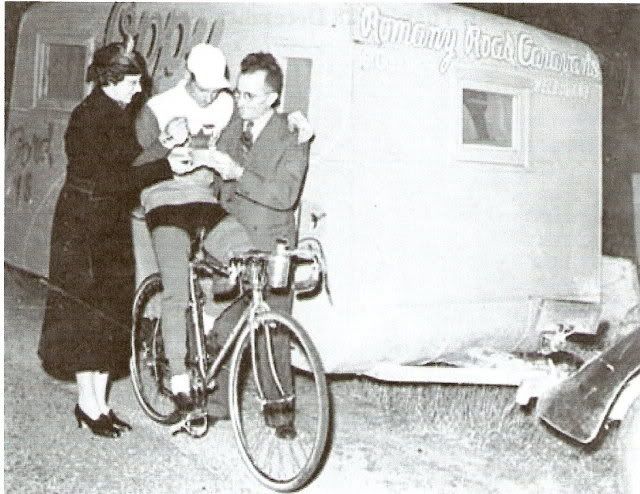 Cobber. |
|
|
|
Post by Don Ricardo on Oct 10, 2009 15:09:04 GMT 10
Some more Romany Road caravan history... A 1937 Romany Road caravan offered as a prize for the Chevrolet Car Club: The Argus, Tuesday, 10 August 1937, p 11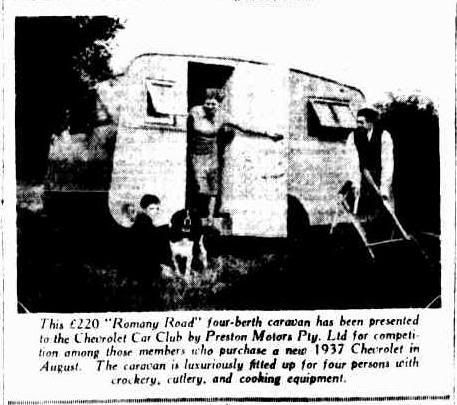 (Source: National Library of Australia nla.go.au/nla.news-article11088585 ) ...and the WINNER IS: The Argus, Tuesday, 10 August 1937, p 11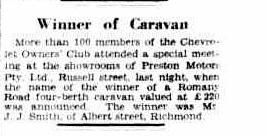 (Source: National Library of Australia nla.go.au/nla.news-article11097612 )
1937 advert: The Argus, Saturday 20 November 1937, p 14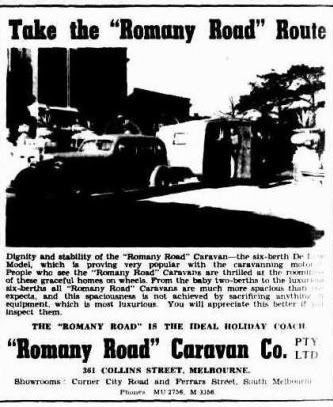 (Source: National Library of Australia nla.go.au/nla.news-article11125871 )
A Romany Road motor caravan built for Mr G R Nicholas of Toorak: The Argus, Tuesday 8 February 1938, p 6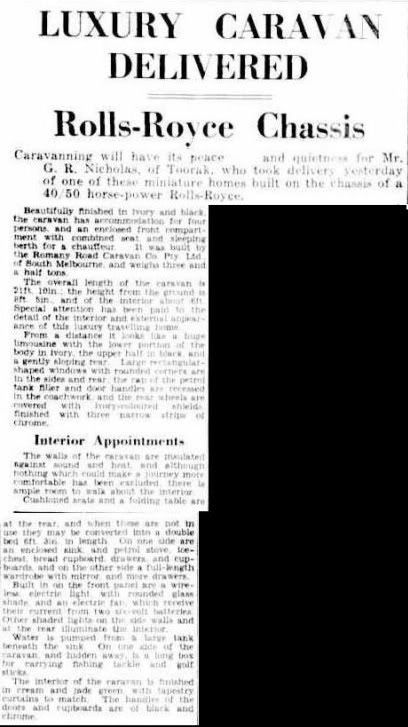 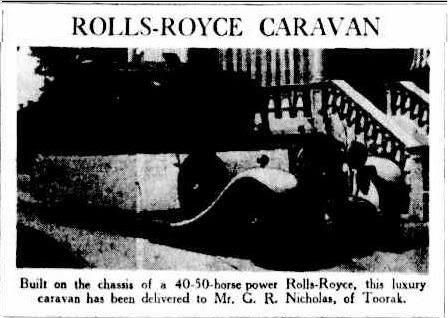 (Source: National Library of Australia nla.go.au/nla.news-article11147023 ) Transcription of the text:"LUXURY CARAVAN "DELIVERED "Rolls-Royce Chassis "Caravanning will have its peace and quietness for Mr. G. R. Nicholas, of Toorak, who took delivery yesterday of one of these miniature homes built on the chassis of a 40/50 horse-power Rolls-Royce. "Beautifully finished in ivory and black, the caravan has accommodation for four persons, and an enclosed front compartment with combined seat and sleeping berth for a chauffeur. It was built by the Romany Road Caravan Co. Pty. Ltd., of South Melbourne, and weighs three and a half tons. "The overall length of the caravan is 21ft. 10in.; the height from the ground is 8ft. 5in., and of the interior about 6ft. Special attention has been paid to the detail of the interior and external appearance of this luxury travelling home. "From a distance it looks like a huge limousine with the lower portion of the body in ivory, the upper half in black, and a gently sloping rear. Large rectangular shaped windows with rounded corners aro in the sides and rear; the cap of the petrol tank filler and door handles are recessed in the coachwork, and the rear wheels are covered with ivory-coloured shields, finished with three narrow strips of chrome. "Interior Appointments "The walls of the caravan are insulated against sound and heat, and although nothing which could make a journey more comfortable has been excluded, there is ample room to walk about the interior. "Cushioned seats and a folding table are at the rear, and when these are not in use they may be converted into a double bed 6ft 31n in length. On one side are an enclosed sink, and petrol stove, ice chest, bread cupboard drawers and cupboards and on the other side a full-length wardrobe with mirror, and more drawers. "Built in on the front panel are a wireless, electric light with rounded glass shade, and an electric fan which receive their current from two six-volt batteries. Other shaded lights on the side walls and at the rear illuminate the interior. "Water is pumped from a large tank beneath the sink. On one side of the caravan, and hidden away, is a long box for carrying fishing tackle and golf sticks. "The interior of the caravan is finished in cream and jade green with tapestry curtains to match. The handles of the doors and cupboards are of black and chrome." Looks like the Chaffeur had to sleep sitting up!! ;D ;D ;D
New showrooms in Carnegie: The Argus, Wednesday 13 April 1938, p 8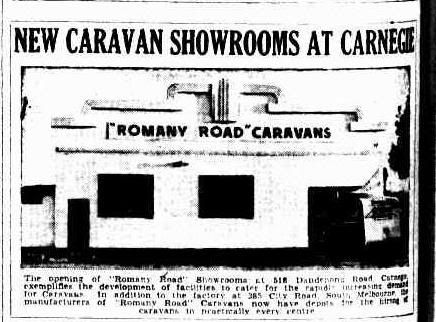 (Source: National Library of Australia nla.go.au/nla.news-article11166886 ) The first sentence reads: The opening of "Romany Road" Showrooms at 518 Dandenong Road, Carnegie exemplifies the development of facilities to cater for the rapidly increasing demand for Caravans." This factory was in addition to the Romany Road factory in City Road, South Melbourne.
...but still they couldn't keep up: The Argus, Wednesday 14 April 1938, p 2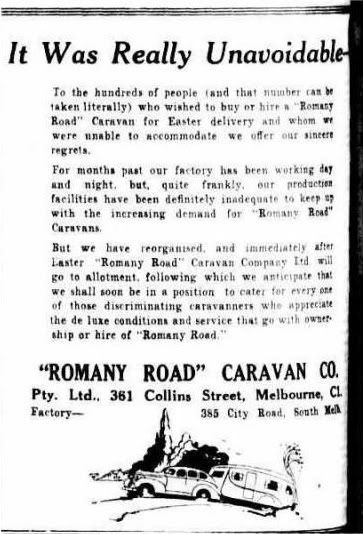 (Source: National Library of Australia nla.go.au/nla.news-article11176495 ) |
|
|
|
Post by cobber on Oct 10, 2009 16:54:14 GMT 10
Then in July 1940 "Romany Road Caravan Co. Ltd. went into liquidation........ that is, during WW2 things got a bit too tough for many of these caravan companies that had started up with great optimism in 1936 and 1937.
In the Matter pt 1 ROMANY ROAD CARAVAN CO LTD (In Lia) 361 Collins Street. Melbourne-Notice Is hereby given that the above named company by extraordinary resolution dated 24th July 1940 went into voluntary liquidation and that I aubert Jeffery, of 271 Collins street Melbourne chartered accountant (Aust ) was appointed liquidator The creditors of the above named company are required on or before the 5th day or September 1940 to SEND their NAMES ADDRESSES and PARTICULARS of their DEBTS and CLAIMS and the name and address of their solicitors if any to the said
Gilbert Jeffery and if so required by notice in | writing from the said liquidator or by his solicitor. to come In and prove the said debts or claims at , such time and place as shall be specified in such
notice or In default thereof they will be excluded I from the benefit or any distribution mode before such debts are proved ,
Dated this 25th day of July 1940 \ " GILBERT JEFFERY Liquidator ¡ National Bank Chambers 271 Collins street, .
Cobber.
|
|
|
|
Post by cobber on Feb 17, 2011 14:59:49 GMT 10
From the English magazine “The Caravan” October 1937. Indicating that both “Romany Road” and “Caravan Construction Company” (Land Cruiser) were going great guns just prior to WW2. Here it tells us Romany Road were turning out a caravan at the rate of one per day. 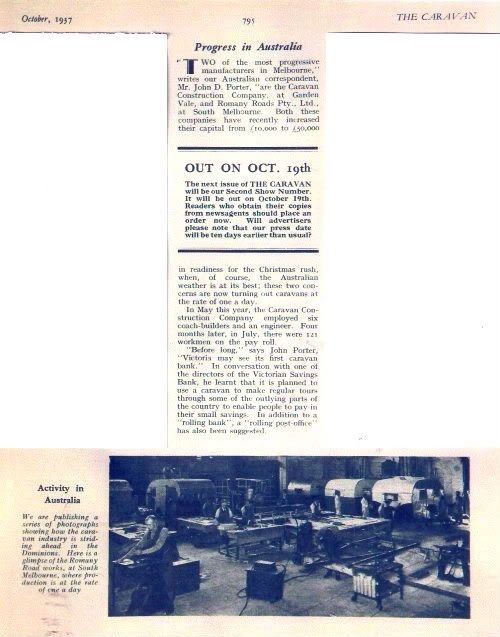 Cobber.
Editorial note: The photograph accompanying the above article is described as being of the 'Romany Road works', but the caravans being constructed seem to be actually Land Cruiser models, based on the shape and livery. It is therefore likely that the photo is of the Land Cruiser factory in Gardenvale. Don Ricardo |
|
|
|
Post by cobber on Feb 26, 2011 7:09:59 GMT 10
This photo is taken from an article printed in the English magazine “The Caravan” in April 1939. It is mentioned in the article that Mr. Collister is connected with the Romany Road Caravan Co. Ltd. The Bushfires mentioned were the Black Friday fires of January 1939.  Cobber.
Editorial note: Despite the apparent link between Mr Collister and the Romany Road Caravan Co Ltd noted by Cobber, later research indicates that the caravan in the photo is most likely a Windsor - click here. Whether there was a connection between Romany Road and Windsor is unknown at this stage. Don Ricardo |
|
|
|
Post by cobber on Feb 27, 2011 8:16:28 GMT 10
F/F said SO....... how many times have you been to look at it in the past TWO WEEKS !! this could be the only one in existence mate  Cobber. |
|
|
|
Post by Don Ricardo on Feb 27, 2011 14:44:03 GMT 10
Hi Cobber,
I just re-read the article you posted on 17 February (Reply #4) re Romany Road and Landcruiser/ Caravan Construction Company production. The photo accompanying the article says it is a pic of the Romany Road production line, but I wonder if that description is in error?
All of the other photos of Romany Road vans (including the one you posted in Reply #5) are very uniform in design - quite square with a sloping front - and quite unlike the vans in the pic which is supposedly of the Romany Road factory. Those vans look much more like Landcruisers to me.
Your thoughts?
Don Ricardo
|
|
|
|
Post by cobber on Feb 27, 2011 16:55:23 GMT 10
G'day Don R, You and your analytical mind..... will be the death of me  I can't decide if your point is valid or not  . Looking at the three different sized models in the centre rear of the photo, and assuming the vans are front on....It looks as though they are lined up in order of size, smallest on the left. We know the “Royal” was the smallest of the Land Cruisers at 12'8'' (no lantern roof)... the “Regent was next at 14' with a lantern roof.... and the “Victory” was the largest at 16' (no lantern roof) All three vans in the photo appear to have rounded fronts with front windows close to the roof line & none of them with a lantern roof.... (I don't think that is a lantern roof on the largest one)  . We know the “Royal” had a rounded front and a window close to the roof line.... so that could possible be a Land Cruiser. We know the “Regent” had a flat front and rear.... with a very small front window well below the roof line and it had a lantern roof... no evidence of that in this photo, I'd say it is not a Land Cruiser. We know the “ Victory” had a very rounded front with a very small window well below the roof line The van in this photo has a larger window close to the roof line so... I don't think it is a Land Cruiser. Of course if we are looking at the rear of the vans the assumptions may be different... except to say none of them look like the “Regent” model to me.There are differences in the paint lines too, but I don't think we can put too much money on that as evidence one way or the other. Agreed..... none of them look like the photos of the only Romany Road van we have seen to-date, and from the scant knowledge we have of Romany Road it would appear they only had one model. So..... maybe you are right and John D. Porter is in error.... or the editor of The Caravan is in error. What do you think I should do Don R. …..move the photo to the “Land Cruiser” thread  Cobber. |
|
|
|
Post by griffin on Feb 27, 2011 18:53:25 GMT 10
This advertisement from the Australian Caravan Magazine and Log Manual in 1938 shows the Romany Road Model "A" to be a pretty flash unit according to the list of inclusions, I mean, a cocktail cabinet and a lavatory, shower and a radio, I think I could handle one today  As for the vans in the factory photo they certainly seem to be a different shape van to the Romany Road. While I'm very much a novice on vintage vans I can say that from years of researching old motoring magazines I've found that editors in the early days certainly didn't worry about the facts getting in the way of a good story. I've found many examples of the same photo being dredged up years after being first published and re-captioned, often incorrectly and used again in articles. Someone may have sent the wrong photos or they may have been genuinely mixed up or simply looked better on the layout. Just one to speculate on. George  |
|
|
|
Post by Don Ricardo on Feb 27, 2011 22:26:47 GMT 10
Hi Cobber and Griffin,
I think Cobber is right in saying that none of the vans look like a Land Cruiser Regent, which in general profile looks more like a Romany Road as it happens. I am guessing that - as Cobber has suggested - the smaller vans may be Royals, and the larger vans may be Victorys - the shape and livery seem to match up with those two models.
As for the window size, my general observation from reading Winser manuals is that manufacturers often updated the features in their vans without updating their publicity material. Thus larger front windows may have been introduced at some stage, but we do not have a photographic record.
I agree with Griffin re mix ups of photos and descriptions - how does it go? Many a slip twixt the cup and the lip? Even today you see plenty of examples where photos and names get mixed up.
So, what to do with the photo we have been discussing? At this point I think the evidence points to an error in the publication, so I would be inclined to post a copy on the Land Cruiser thread with an explanation that it appears that the pic is of the Caravan Construction Company factory, and leave the pic here as well with this discussion. I think that's called a bob each way! ;D ;D ;D
Don Ricardo
|
|
|
|
Post by cobber on Mar 11, 2011 8:39:18 GMT 10
Another photo from The Caravan magazine... this one from the February 1938 issue. It states that Mr. G.H. Swan is the managing Director of the Land Cruiser Company which I think is news to us  We have only heard of Mr. F.C. Heber as Managing Director of the company and I have spoken with F.C's Son prior to his death in July 2009 and there was no mention of his father relinquishing the position at any time   Cobber.
Editorial note: Cobber's post was originally posted on the Land Cruiser thread, but as indicated below the photo in this post is in fact a Romany Road, and G H Swan was the Managing Director of the Romany Road company. Don Ricardo |
|
|
|
Post by cobber on Mar 11, 2011 9:17:51 GMT 10
OK.......... Problem solved  This article in the Melbourne newspaper The Argus of January 1939 Concerns a Mr. G. H. Swan who is the Managing Director of "Romany Road Caravan Co. Ltd."Apparently there was some confusion between Romany Road and Land Cruiser in the minds of The Caravan people This is an interesting item none the less... The Black Friday fires and Romany Road Caravans were coupled together again in January 1939. 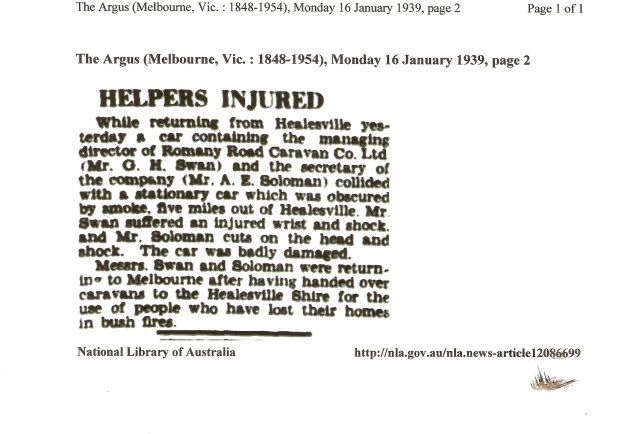 Cobber.
Editorial note: This post merges two posts by Cobber relating to the Argus article. Don Ricardo |
|
|
|
Post by Don Ricardo on Mar 16, 2011 22:14:11 GMT 10
Here is another photo of, and article about the caravan which accompanied Sir Hubert Opperman in his record breaking ride from Perth to Sydney. The article is from The West Australian of 1 November 1937 (p 7). From the article posted in Reply #1 above, we know that the caravan was a Romany Road: .jpg?width=1920&height=1080&fit=bounds) (Source: National Library of Australia trove.nla.gov.au/ndp/del/article/41444937 Layout of item altered to improve readability) Note the comment: "This caravan...is practically a traveling home on wheels...". I thought that was the idea of a caravan? But maybe that knowledge couldn't be taken for granted back in 1937... From memory, Bruce Small who is mentioned in the article was the manufacturer of Malvern Star bicycles. Don Ricardo |
|
|
|
Post by Franklin1 on Feb 9, 2014 15:49:46 GMT 10
G'day DonR,
Here's a bit more info from the Perth 'Mirror' newspaper, 30 Oct 1937:
"OPPY will pedal TO SYDNEY
Preparations Under Way
Hubert Opperman, crack Victorian road cyclist, who holds most of the Australian road records, will attempt a marathon ride to Sydney next week, and preparations are well in hand for the trip.
In the capable hands of H. G. (Herb) Elliot and his nephew, H. C. (Herb) Elliot, the Romany road caravan, which will accompany the lion-hearted cyclist on his long ride, arrived after a rough trip overland about 10.15 a.m. today, and was met by Mr. and Mrs. Opperman, Mr. Bruce Small (who had arrived earlier on the Trans-train), and a crowd of interested onlookers. The caravan is neatly and compactly fitted out with three mattress bunks, wash-basin with running water, a wireless set (broken on the rough journey over), an ice-chest, a wardrobe with mirror, and cupboards for crockery and cutlery. It is small but comfortable, with windows on three sides shaded by lace curtains and blinds. A most snug little conveyance, but very hot in the middle of Australia, we should imagine! The interior is painted cream and, apart from the inevitable red dust which had collected in the drawers and transformed the cutlery, everything is spotless.
The caravan is a two-wheel type with a streamlined appearance, and the rough passage through the dangerous Madura Pass caused the Elliots a lot of concern. On one occasion it turned over, but no serious damage was done. Mr. Bruce Small, who on behalf of Malvern Star Ltd. is sponsoring the trip, arrived by the Trans this morning to meet the caravan. He will accompany the cyclist during his ride, and Mrs. Opperman will see to the cooking on the caravan's stove."
|
|
|
|
Post by Don Ricardo on Jul 4, 2015 18:21:24 GMT 10
Photo of a Romany Road caravan published in Table Talk on Thursday, 27 May 1937 (page 33):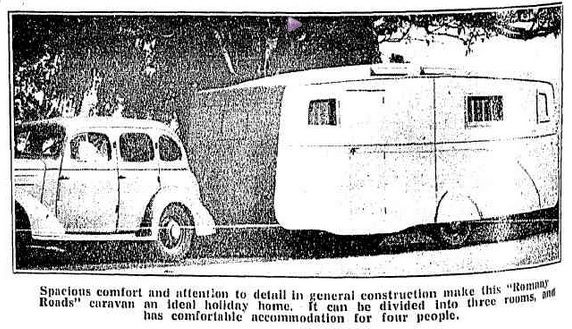 (Source: National Library of Australia nla.gov.au/nla.news-article149327904 ) Advert from the same edition of Table Talk (page 16) showing the rear of the caravan: 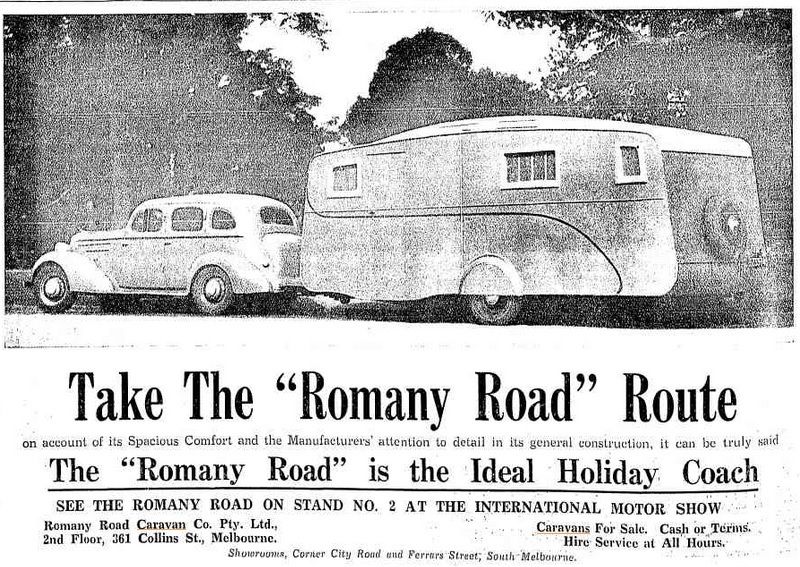 (Source: National Library of Australia nla.gov.au/nla.news-article149327897 )
Extracts from an article published in Table Talk on Thursday, 20 May 1937 (pages 42 & 43 ) describing the Romany Road 'Double Saloon Four' model caravan shown above, which was on display at the 1937 Melbourne motor show: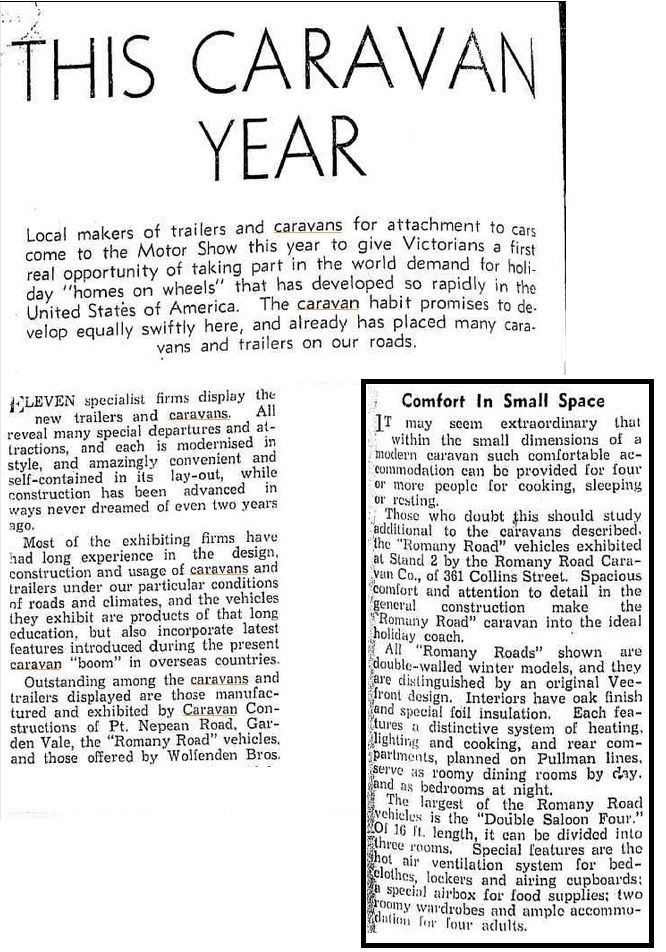 (Source: National Library of Australia nla.gov.au/nla.news-article149327813 )
|
|
|
|
Post by Don Ricardo on Sept 2, 2017 14:56:01 GMT 10
Hi all, Higher up this thread is a copy of an article published in the Melbourne Argus in 1938 about a Romany Road motor caravan built on a Rolls Royce chassis for a Mr G R Nicholas. The photo accompanying the article was not very clear in that article, but a clearer photo was published in the Melbourne Australasian newspaper on Saturday, 19 February 1938 (page 41):  (Source: National Library of Australia nla.gov.au/nla.news-article144367933 ) 'G R Nicholas', for whom the caravan was built, was George Richard Rich Nicholas, a pharmacist who developed the Aspro during World War I when supplies of aspirin were no longer available from the German company Bayer. The Nicholas family became wealthy off the back of the world wide sales of Aspro, and also became well known philanthropists. And I guess he could well afford a caravan built on a Rolls chassis! If you grew up in Melbourne in the 50's, as I did, the Nicholas name was well known and there are various landmarks around Melbourne which are connected to the Nicholases. In fact I reckon that most Australians around my age would probably recognise a pack of Nicholas Aspros by the colour of the pack (pink). However I think that Aspros are now produced as a generic medicine, and I doubt if my kid's generation would even recognise the significance of the Nicholas name. Griffin has sourced the original of the photo of Nicholas's Rolls Royce/Romany Road motor caravan published in the newspapers from the R-R Owners' Club of Victoria - click here. It was definitely a magnificent beast! Don Ricardo
ADDENDUM - September 2022: The following article published in the Mackay Daily Mercury on Monday, 27 June 1938 (page 10) refers to the Nicholas's Rolls Royce based motor caravan (see highlight): _Mon_27Jun1938_p10_article169990626.png?width=1920&height=1080&fit=bounds) (Source: National Library of Australia nla.gov.au/nla.news-article169990626 Highlight added and layout modified for readability on the forum) Don Ricardo |
|
|
|
Post by Don Ricardo on Aug 6, 2022 19:30:38 GMT 10
Hi all, Another photo of the Romany Road caravan used by Hubert Opperman, later a federal government Minister and Sir Hubert Opperman, in his record breaking bicycle ride from Fremantle to Sydney in 1937. This photo was used to illustrate an article on caravan holidays published in the Sydney Daily Telegraph on Friday, 19 November 1937 (page 20). I'm not sure you could call Opperman's bike ride across Australia a 'holiday' though! _Fri_19Nov1937_p20_article247327767.png?width=1920&height=1080&fit=bounds) (Source: National Library of Australia nla.gov.au/nla.news-article247327767 ) Further details and photos of the Opperman ride are shown higher up this thread. It seems as if providing a caravan for the event was one of Romany Road's major marketing tools.
As a complete aside, Sir Hubert Opperman lived in the same retirement village as my mother-in-law in the 1990's and was still riding his bike daily in his 90's. All that exercise must have paid off! Shesgotthelook will also tell you that Sir Hubert was Rochester's (Vic) most famous son.
Don Ricardo |
|
|
|
Post by Don Ricardo on Feb 8, 2023 11:39:11 GMT 10
Photograph of a lineup of Romany Road caravans taken by Ivan Southall, from the State Library of Victoria collection The photo was most likely taken sometime between 1936/7 when Romany Road commenced operation and 1940 when it went into liquidation. 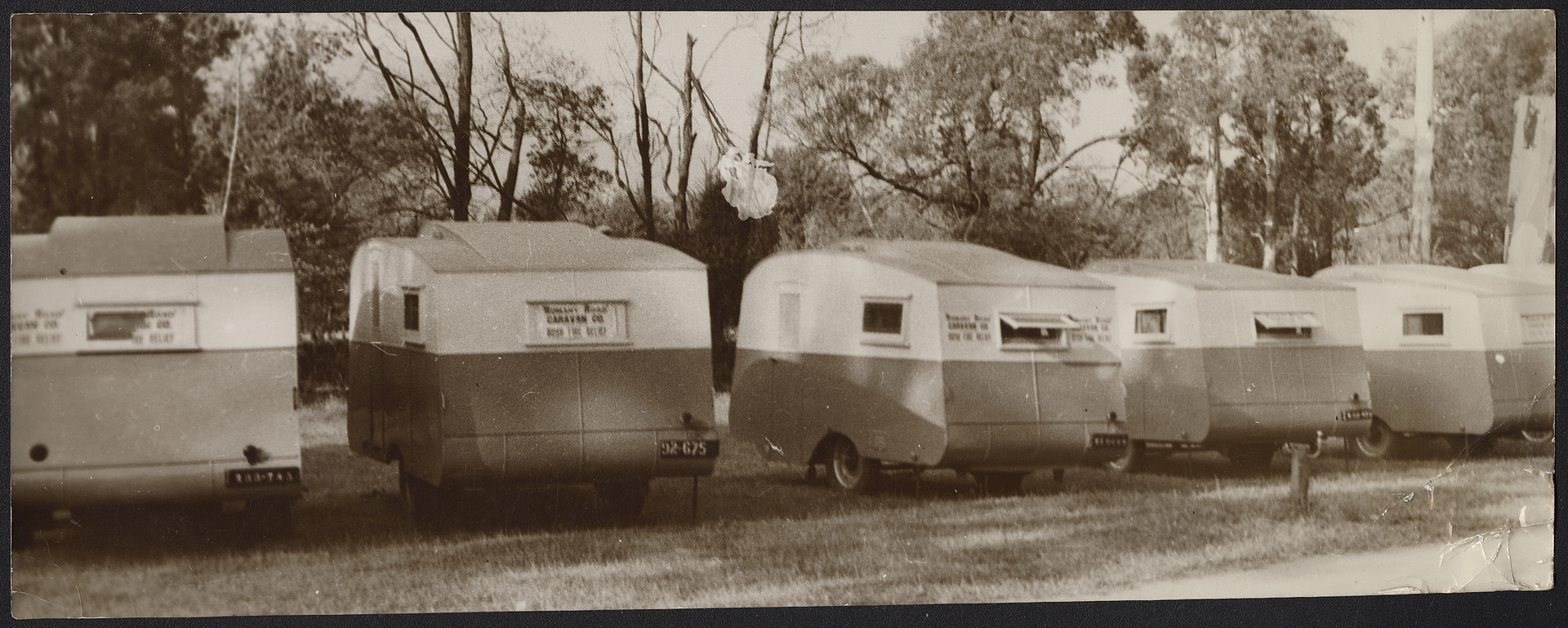 (Source: Ivan Southall Collection, State Library of Victoria find.slv.vic.gov.au/permalink/61SLV_INST/17t49l2/alma9937073463607636 ) Thanks to Woody99 (Andrew Woodmansey) for the link to this photo. Don Ricardo
|
|
|
|
Post by Don Ricardo on Feb 9, 2023 11:50:51 GMT 10
Photos of a Romany Road caravan used to illustrate an article on the 'caravan cult' in Pix magazine on 31 December 1938 (Vol 2, No 27, page 15): (Source: National Library of Australia nla.gov.au:443/tarkine/nla.obj-468538468 )
|
|